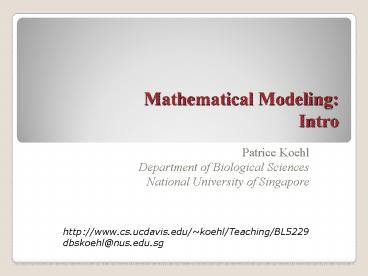Mathematical Modeling: Intro - PowerPoint PPT Presentation
1 / 18
Title:
Mathematical Modeling: Intro
Description:
Mathematical Modeling: Intro Patrice Koehl Department of Biological Sciences National University of Singapore http://www.cs.ucdavis.edu/~koehl/Teaching/BL5229 – PowerPoint PPT presentation
Number of Views:204
Avg rating:3.0/5.0
Title: Mathematical Modeling: Intro
1
Mathematical ModelingIntro
- Patrice Koehl
- Department of Biological Sciences
- National University of Singapore
http//www.cs.ucdavis.edu/koehl/Teaching/BL5229 d
bskoehl_at_nus.edu.sg
2
Science, then, and now
At the beginning, there were thoughts, and observa
tion.
3
Science, then, and now
- For a long time, people thought that it would be
enough to reason about the existing knowledge to
explore everything there is to know. - One single person could possess all knowledge in
her cultural context. - (encyclopedia of Diderot and DAlembert)
- Reasoning, and mostly passive observation were
the main techniques in scientific research
4
Science, then, and now
5
Science, then, and now
- Todays experiment yields massive amounts of data
- From hypothesis-driven to exploratory data
analysis - - data are used to formulate
- new hypotheses
- - computers help formulate
hypotheses - No single person, no group has an overview of
what is known
6
Science, then, and now
7
Science, then, and now
- Computer simulations developed hand-in-hand with
- the rapid growth of computers.
- A computer simulation is a computer program that
- attempts to simulate an abstract model of a
particular - system
- Computer simulations complement theory and
- experiments, and often integrate them
- They are becoming widesepread in Computational
- Physics, Chemistry, Mechanics, Materials, ,
Biology
8
Science, then, and now
9
Mathematical Modeling
- Is often used in place of experiments when they
are too large, too expensive, too dangerous, or
too time consuming. - Can be useful in what if studies e.g. to
investigate the use of pathogens (viruses,
bacteria) to control an insect population. - Is a modern tool for scientific investigation.
10
Mathematical Modeling
11
Mathematical Modeling
Real World
- Define real world problem
- - Perform background research
- Perform experiments,
- if appropriate
Task Understand current activity and predict
future behavior
12
Mathematical Modeling
- Simplification define model
- Identify and select factors to
- describe important aspects of
- the Real World Problem
- determine those factors
- that can be neglected.
Simplified Model
13
Mathematical Modeling
- Represent mathematical model
- Express the simplified model
- in mathematical terms
- the success of a
- mathematical model depends
- on how easy it is to use and
- how accurately it predicts
Mathematical Model
14
Mathematical Modeling
- Translate computational model
- Change Mathematical
- Model into a form suitable
- for computational solution
- Choice of the numerical method
- Choice of the algorithm
- Choice of the software (Matlab)
Computatonal Model
15
Mathematical Modeling
- Simulate Results
- Run Computational Model
- to obtain Results
- draw Conclusions.
- Graphs, charts, and other visualization
- tools are useful in summarizing results
- and drawing conclusions.
Results
16
Mathematical Modeling
- Interpret
- Compare conclusions with
- behavior of the real world
- problem
- If disagreement, modify Simplified
- Model and/or Mathematical model
17
Syllabus
- Introduction to Matlab
- The tools of the trade
- Data analysis
- Data modeling
- Clustering
- Fourier analysis
- Simulations (Monte Carlo)
18
References
Cleve Moler, Numerical Computing with MATLAB,
2004. (http//www.mathworks.com/moler)































